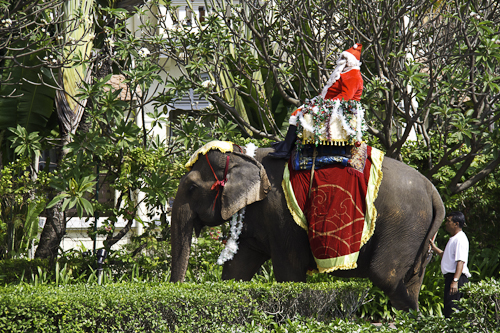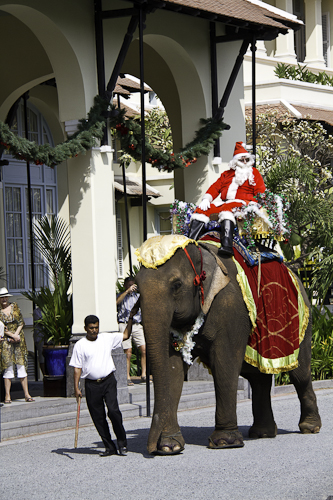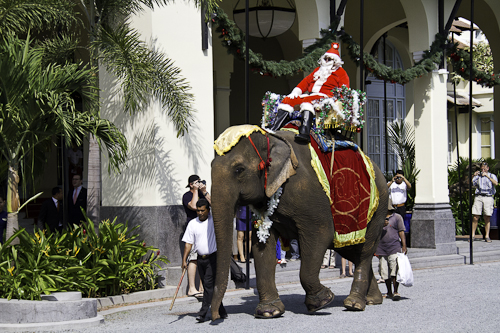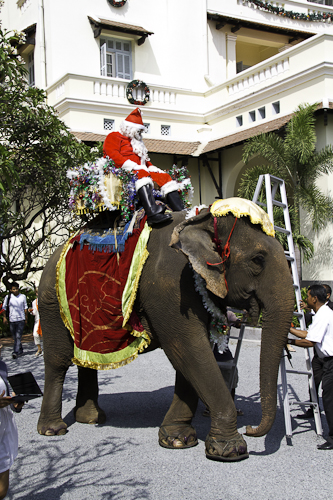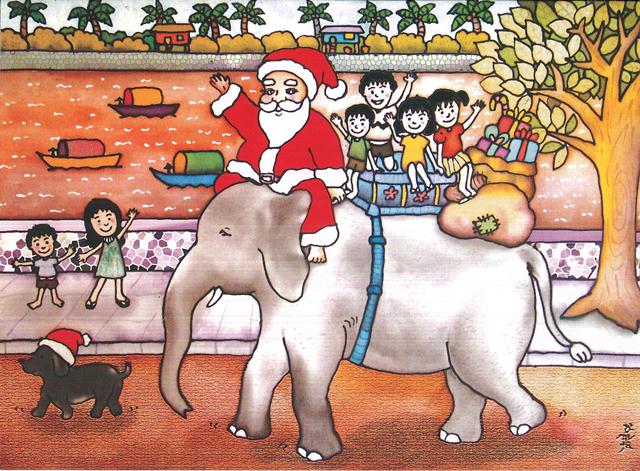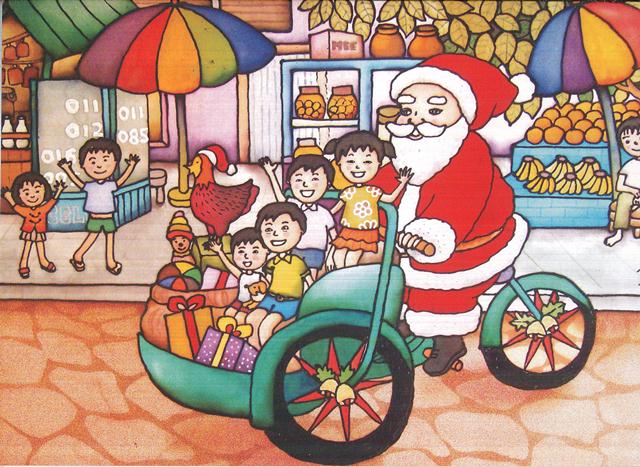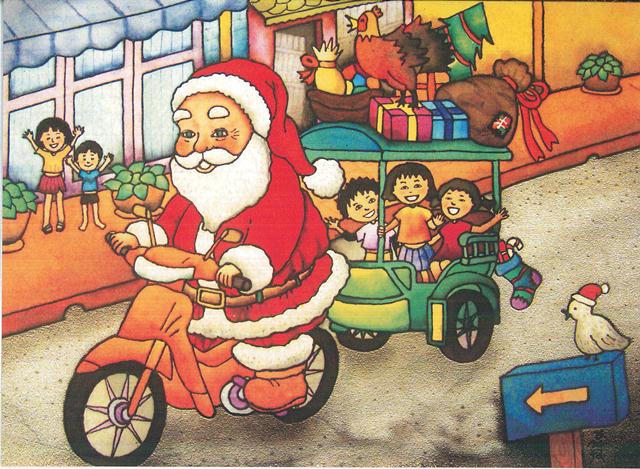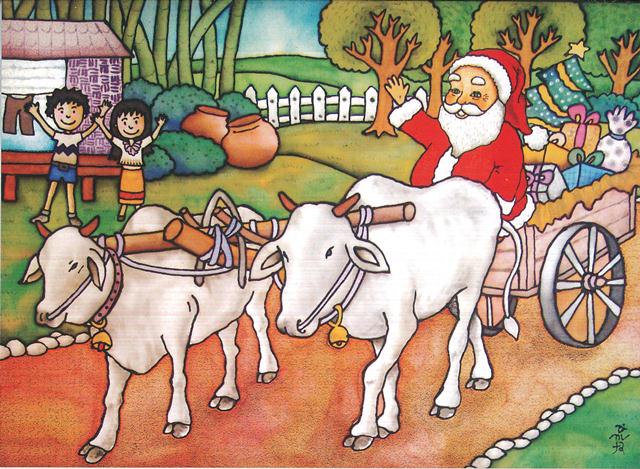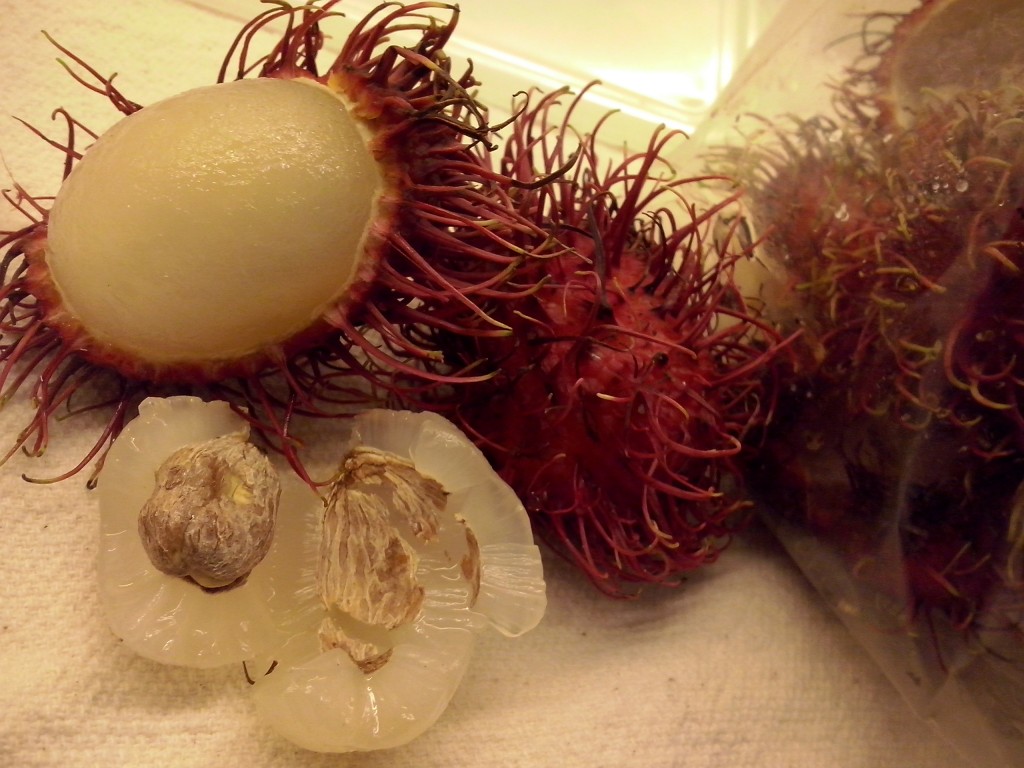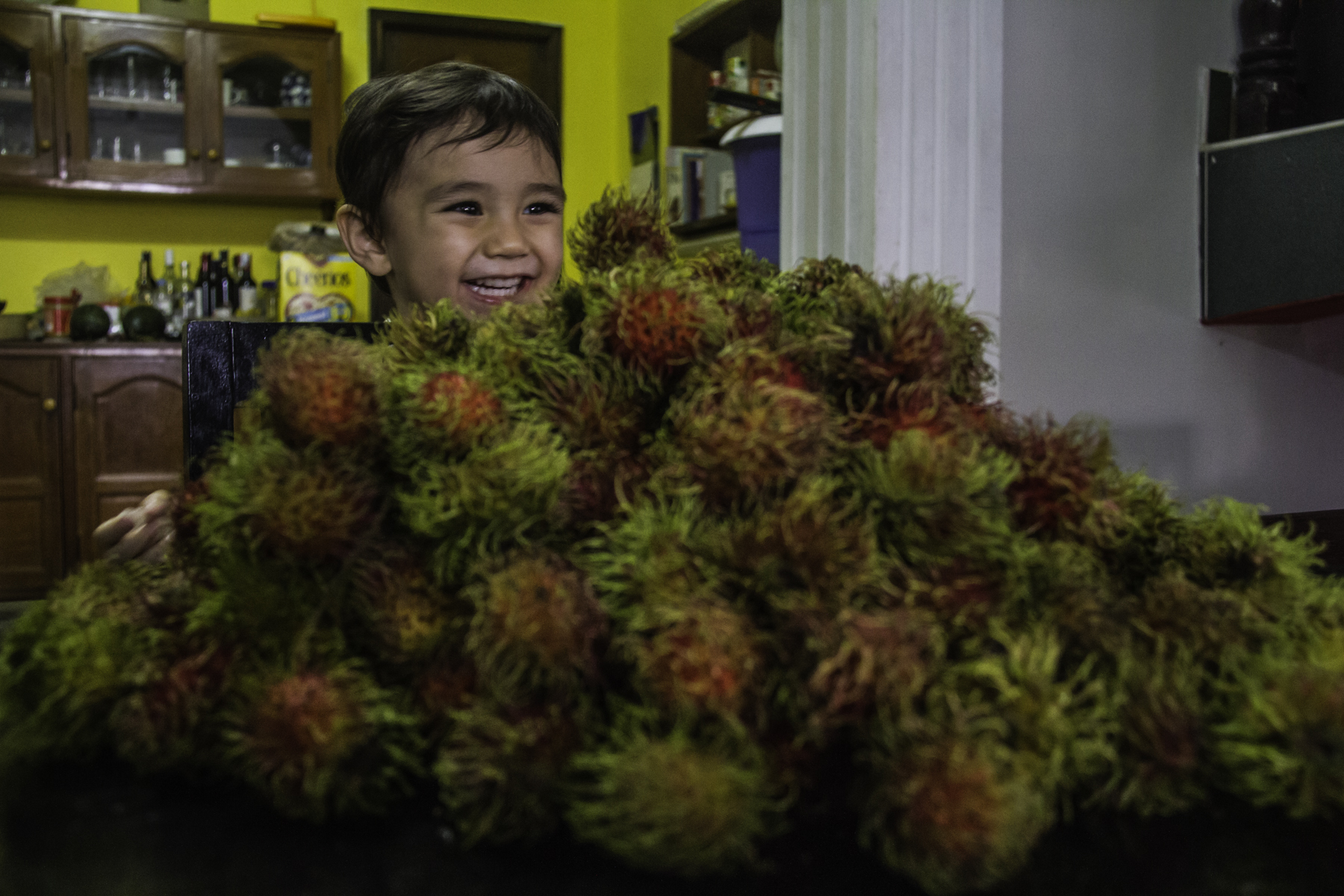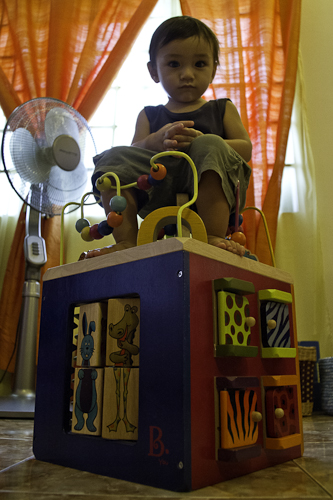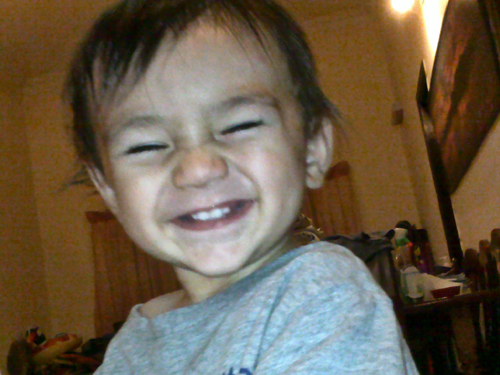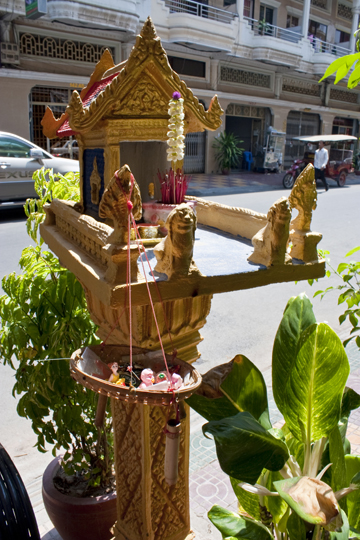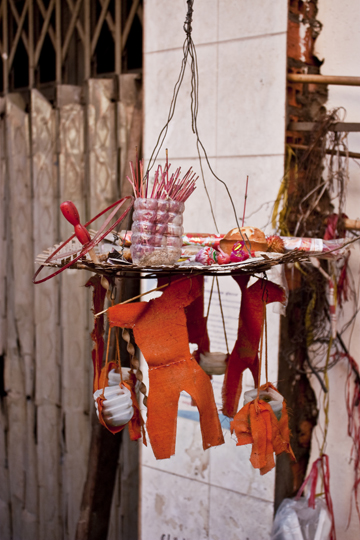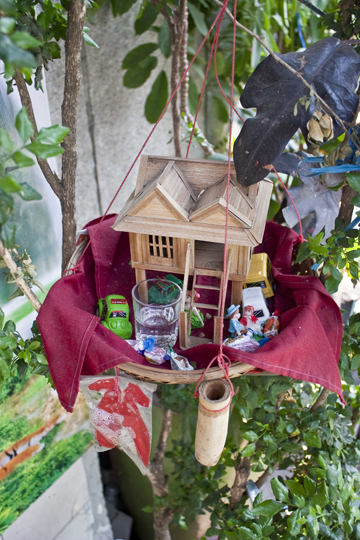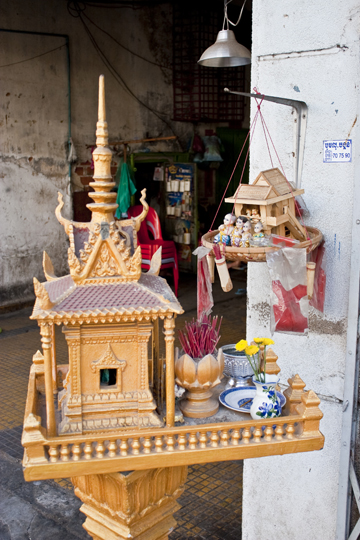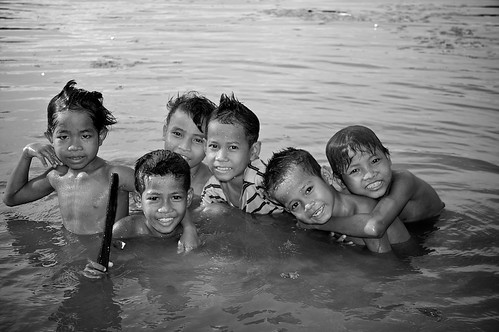Our son’s first word (apart from mama and papa) was elephant – every time we pointed to an elephant in one of his books he’d say “peh-pet”. Last year he was still a bit young to appreciate the celebration of Christmas, and was afraid of Santa Claus, even when he arrived with his favorite creature, Sambo the elephant. This year we milked that naughty/nice list idea cuz it works like a charm – it’ll be a treat to watch this little boy on Christmas morning now that he knows better. Sambo, happily, is no longer a regular on Phnom Penh’s busy riverside. He retired this year to a zoo.
Khmer
Christmas cards with a Khmer twist
I bought these cards at a Women’s International Group (WIG) Christmas Fair a few years ago. On the back of the cards is a copyright for Global Art and Anita Dean who, from a quick google search, is the founder of Global Art, Phnom Penh. I wish they printed the name of the artist too.
Anyway, I hope I’m not breaking any copyright rules by scanning and posting these beautiful cards. If anyone knows who the artist is, please leave a comment!
Tropical fruit: Rambutan
I’m not a big fan of Rambutan (saw-maw in Khmer), mostly because the woody bark of the seed comes off with the meat (I guess it’s added fiber – see the picture below). But it’s incredible how much of this fruit our son can devour in one sitting. So I came home with 5kgs of it from a friend’s local farm and wouldn’t you know, some kid passed around Hand Foot Mouth at his petri dish pre-school and he broke out in rashes sores and blisters. Rambutans are too acidic for his mouth sores so he can only stare at them :-(
building communication skills to help with the Terrible Twos
At 15 months, we’re getting a premature taste of the infamous Terrible Two stage. Our little boy’s personality seems to be developing along what the books call “spirited” or “strong-willed”, even “high-need” (although this last term is politically incorrect anymore). His Khmer nanny is bewildered and amused at the range, intensity and volatility of emotion he exhibits. He can be blissfully happy one second and thrashing about in a full rage for the next two hours. It sets him off when we don’t understand what he wants. With redirecting a bit more difficult now we’ve had to be creative.
Thankfully he’s developed some decent communication skills early on. The fact that signing and verbalizing are still novel to him at this stage, and that it gets a lot of positive attention, means we can exploit this! So we’re trying to help him realize that there are better ways to get his point across than through a tantrum.
He can sign. We signed to him since he was just a few weeks old, so he knows the basic ones like mum-mum (mom’s milk), finished, change the diaper, hurt and sleep. He demonstrates that he understands the signs but he doesn’t use all of them.
His verbal skills are excellent. His first words at just a little over a year old were mum-mum, chkai (dog), fish and turtle. Today his ramblings are sprinkled with big words or phrases like elephant (“puh-pet”), octopus (“AHH-puhpuh”), chipmunk (“muh-munk”), kangaroo (“rah-rah-rooo”), other side (“uhh-thuh-thai”).
And as with any multilingual and/or expatriate families, he’s is exposed to several languages. His nanny doesn’t speak English and most people he meets prattle at him in Khmer. I try to talk to him in Tagalog and one of our neighbors who he frequently interacts with speaks to him in Bengali.
Interestingly, he uses whichever language is easier for the word he wants to use. For example, he’ll say svai rather than mango, awluk rather than watermelon. We aren’t necessarily teaching him all four languages – but we want to give him that kind of exposure. I and most of my friends grew up in a 3+ language family and there’s increasing evidence it augments cognitive development. That he can choose between them to find the easiest way to say what he wants to say is a bonus!
And at this stage he gestures a lot. He asks to be picked up and we just follow his pointing signals.
The main point is that communication has been a huge tool in helping us deal with the Terrible Twos. It’s fascinating to watch this little boy communicating his wishes (what goes on in their little heads?!). He can now usually get his point across early so we can either accommodate him or anticipate and redirect temper flares. It’s a tiring and frustrating but very rewarding phase, “growing” this littler person!
offerings to the small lost souls..
This post is about Merenang Kang Veal, the memorials and offerings to those who’ve passed into the next life while still very young (from the aborted to the stillborn to those who died at a very young age). The relationship with nature and all living things whether still on earth or physically gone is still very tangible and real in Asia and the Khmer’s Buddhist tradition. These shrines and offerings are an effort by those still alive to pay respects and appease the wandering and lost spirits. Notice the toys and miniature clothes, food and water given as offerings. We’re doing some research into these to find out more about them. Stay tuned!
Where is Khmer culture going?
With such rapid pace of progress, Cambodia eagerly embraces a bright future. That’s the upside. What’s disheartening is that it’s a future that chases inspiration externally– specifically from the West, while rejecting its own rich legacy and heritage.
Silence about the Khmer Rouge period
With the KR trials commencing, spotlight is on the reaction of the Khmer population. But collective suppression of this period in history is the prevailing practice. Even the international community avoids the issue: aid funding for mental health has been nil, despite numerous requests and rampant indication of need. What little dialogue is had about tribunal activities is mostly aimed at foreigners and international scholars, researchers, interns.
Khmer kids have not an inkling of the import of the Khmer Rouge period. It’s not taught in school, barely mentioned in the home, and no discourse is had in the public sphere. To be ignorant of it is one thing, but I was shocked on arrival that my new friends flat-out deny these atrocities ever even occurred. They say it’s just old people talking to scare them… Here Seth Mydans reports on how Cambodia’s youth know little about the Khmer Rouge atrocities (NYT):
Some older people get so upset at their children for not believing that they say, ‘I wish the Khmer Rouge time would happen again; then you’d believe it,’ Mr. Ty Leap said.
Thought leaders, influencers and the professional cadres were largely eliminated during the KR period, true. But a complete dismantling of the Khmer social infrastructure is reinforced by this large-scale avoidance of the topic. It is a rift, chasm, disconnect that winds and rends through the entire fabric of Khmer society.
Frayed social networks
For thousands of years Buddhism has been the pillar of social cohesion– a vanguard of Khmer culture and moral authority in matters of social and even political affairs. But the abbots’ and monks’ relevance has deteriorated, largely from decimation of the top ranks of the Buddhist order. This left a fragmented social system and a void, at a time it is most needed.
We’re witnessing the extinction of many art forms, from music to fine arts, with little local advocacy. Such cultural expressions usually boom after conflict periods; it is part of a society’s healing process to document memories. But the arts are unsupported, even from the royal family, many of whom including the King are gifted artists. This point is very telling by itself. The royal family does not reside in-country, and the King is (was?) a dance professor in France who spends little of his life here. What better way to convey the message to your people that Khmer culture is sub-par than to abandon the very channels for social expression.
My colleague’s father was a renowned painter prior to the Khmer Rouge period, and his works hang in the National Museum in Phnom Penh. Thoroughly impressed, K requested an interview. Her response? His art is so old, why would he be interested in it when she can introduce him to more exciting contemporary artists instead. She was sure to add that good artists have had training in the West or from Westerners– her father “only” knew Angkorian style.
These are just a few instances of the absence of pride among Khmer for anything Cambodian.
Foreigners’ role in advocating Khmer culture
The generations after the KR only ever knew to aspire to the whims of endless armies of westerners bringing our ideas to them, experimenting on a societal scale at will and for the most part unchecked. Khmers are conditioned to worship the power of the dollar. They’re exposed to and want the excesses they see on the pirated Hollywood blockbusters: fast cars, fast money, throwaway relationships, soundbyte politics and a consumption lifestyle– all a complete flip of the essence of Cambodian philosophy towards life. China, India, Thailand, etc, have all chosen to embrace modernity. But their quest for progress is continuously negotiated against the substance of their cultural identity. Khmers seem not to have this.
Instead of coming from within, foreigners (for lack of elder Khmer mentors) are showing the youth what’s cool about their own Khmer culture. Through the filters of foreign taste, Khmer are learning to appreciate the finer elements of their own traditions. The context is displaced, disconnected, inorganic.
For me, growing up in the US, I was taught the essence of my Filipino heritage in the home, and learned my new country’s cultural nuances through social situations. Most of us have the luxury of this foundation from which to forge our identity, whichever direction that may go. I reject some Filipino and American traditions on the basis that I had grasp of the context. Cambodian kids are given little context from which to move forward.
So what’s in store for Cambodian culture?
Mentors from within the country are still few relative to the boomer population post-KR, but this cadre is steadily growing, (thankfully) embracing their Khmer identity and taking the lead to advocate for it. Ever so slowly, foreigner guidance will give way to this new generation of elders. But it’ll take entire lifetimes. In the meantime, a cultural schizophrenia guides the direction of progress in Cambodia…
